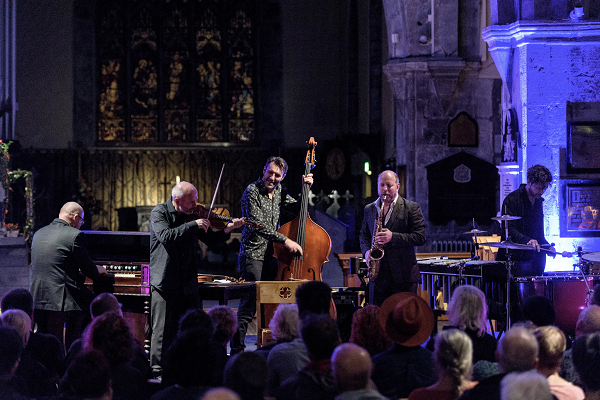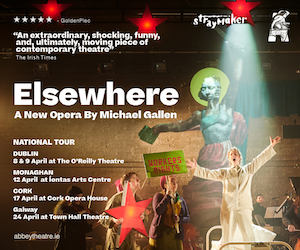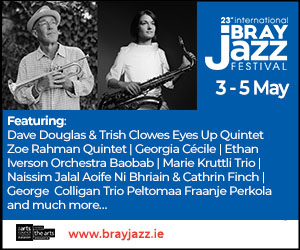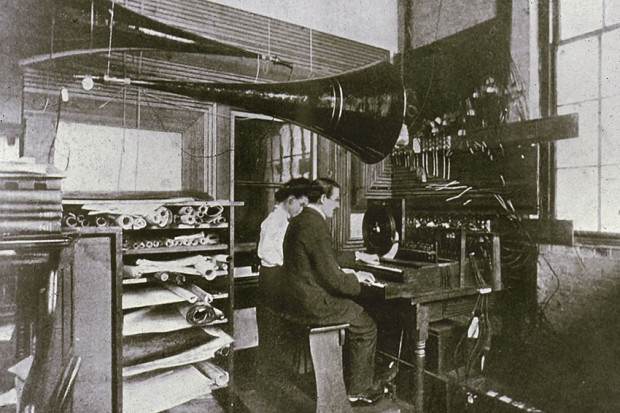
Nils Økland and band performing at St Nicholas’ last week as part of Galway Jazz Festival (Photo: John Cronin, Dublin Jazz Photography)
Impossible Craft
In the final concert of the Galway Jazz Festival, Nils Økland and his band performed to a large audience at St. Nicholas Church (6 Oct.). The Norwegian musician is a renowned hardanger fiddle virtuoso, fusing traditional Norwegian styles with jazz and more experimental, contemporary sounds. Prior to the concert, I had not heard this musician or his unique fiddle live, but on a wet autumnal evening I was brought on a journey of exploration with both. The hardanger fiddle is a highly decorative traditional Norwegian instrument with either eight or nine strings. Four are strung in the same way as a violin and the others are understrings that resonate off the sound of the other four. The result is a sound that is much fuller and richer than a violin, whilst still maintaining all that the violin has to offer.
Layer of sound
The evening began with a haunting melody played by Økland on the hardanger, before the tenor saxophone joined. Økland’s band of Rolf-Erik Nystróm on saxophones, Sigbjórn Apeland on harmonium, Mats Eilertsen on double bass and Håkon Mórch Stene on percussion added layer upon layer of sound to the melody, each creating countermelodies and harmonies effortlessly. The musicians used a variety of traditional and experimental techniques, pushing the limits of their instruments and making the audience constantly ask how they were producing the sounds that filled the church. Mórch Stene used bows to play the vibraphone, Nystróm used his soprano saxophone to produce an airy, wind-like sound that whistled around the vast space, replicating a feeling of being outside on a blustery day. As the music grew bigger with each layer, so too did the hypnotic trance that fell over the audience. We dared not make a sound for fear of missing a moment of what was being created in front of us. Gradually, the musicians removed the melodies they had added, until all that was left was the early simplicity of solo saxophone and the faint pulsing of tribal like drums.
The second piece of the concert was an epic arrangement lasting close to forty minutes. It began with the double bass and fiddle in dialogue with one another, each responding playfully, smacking and plucking their instruments with force. Again, the other instrumentalists started to add their own voice to the music that was being created, each being given the chance to improvise and explore. The music ebbed and flowed while building in texture and dynamic that seemed far beyond what five musicians could make with no loop pedals or technology. If I hadn’t known there were only five players, I would have guessed twenty. The sound vibrated and bounced off the walls, down into the floor and up through your feet to give the audience a physical experience that compelled everyone to lean into the music even more. Looking around you could see people with their eyes closed, completely captivated by Økland and his band, as they played as much for each other as they did us.
Two moments
There were two moments in this piece that had people craning out of their seats to see what was happening. The first moment came when Nystróm, who had been switching between his three saxophones throughout the piece, suddenly started playing soprano and alto saxophone at the same time. Phones were produced as the audience tried to capture this surreal moment. In another context, with another musician, it might not have worked, but Nystrøm made it all seem like this was standard practice. The second moment may not have been planned, as with most of what we heard, for towards the end of the piece, after receiving a nod from Eilertsen on double bass, Apeland stood up from his harmonium and made his way to the back of where the band had been playing. A few minutes later, the church organ burst into life. The other musicians turned their back on us to face Apeland at the organ and began playing towards him. We were the lucky bystanders to their own session and the crowd gave a standing ovation when the piece lulled to an end with Nystróm mimicking a bird call on soprano saxophone.
The final two pieces were encores after the monumental work before it. These arrangements were calmer and subtle, with a clearer sense of Norwegian traditional tunes. While the concert was based around Økland’s album Lysning, this wasn’t a showcase of any particular recording. Motifs were taken from different works and then improvised around and reconstructed. Having listened to Økland’s work before, I felt I knew what I was about to hear, but my expectations were nothing like what I heard. His recorded music acts like a film trailer, giving the listener a taste of what to expect, but not spoiling the ending. There are some artists you must see live to fully appreciate their craft and music. Nils Økland is one such artist.
For more on Nils Økland, visit www.nilsokland.no.
–
This is the seventh review published as part of the Journal of Music/Galway City and County Music Writer Mentoring Scheme 2019 and is supported by Galway City Council and Galway County Council Arts Offices. Over the course of a year the editorial team of the Journal of Music work with six new writers – Rachel Deckard, Massimo Cattaneo, Jake Tiernan and Kerri Haberlin (Galway City), and James Fleming and Tara Broderick (County Galway) – and publish their reviews of music in Galway.
Read more about our previous Music Writer Mentoring Schemes here.
Published on 10 October 2019
Tara Broderick is a teacher and graduate of CIT Cork School of Music. She was a participant in the Journal Music's 2019 Galway City and County Music Writer Mentoring Scheme.















